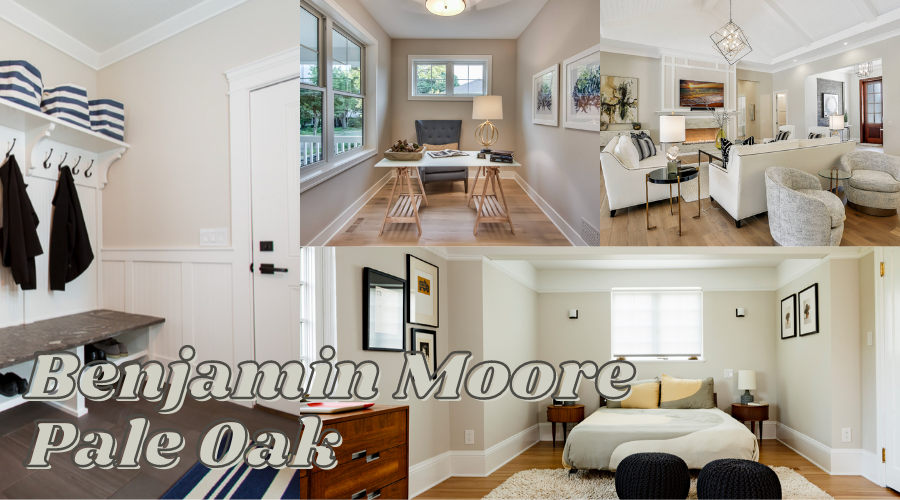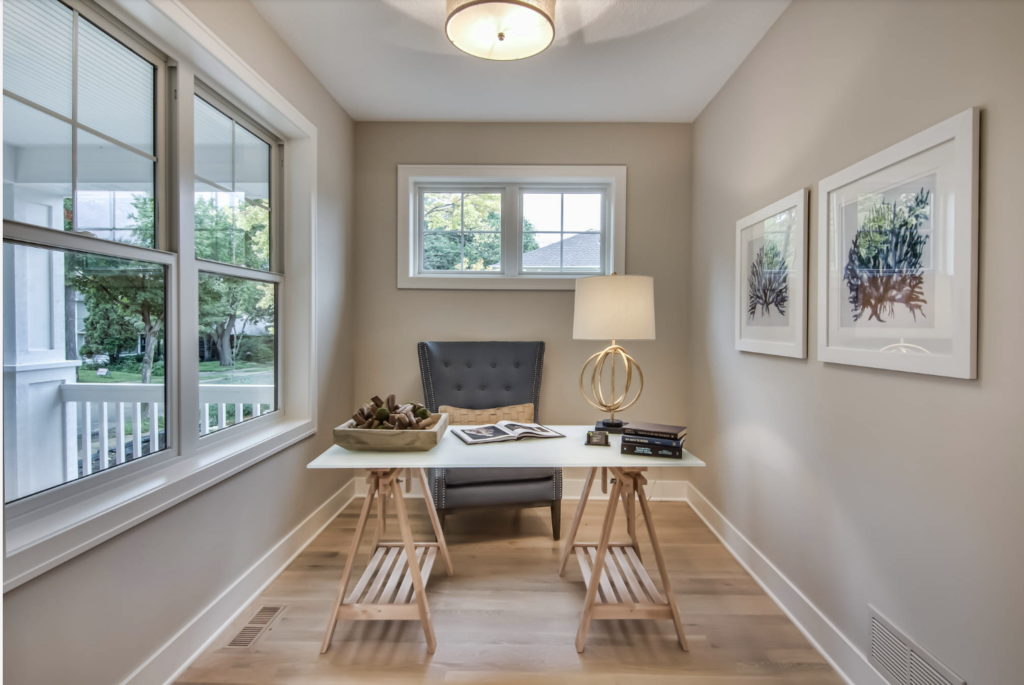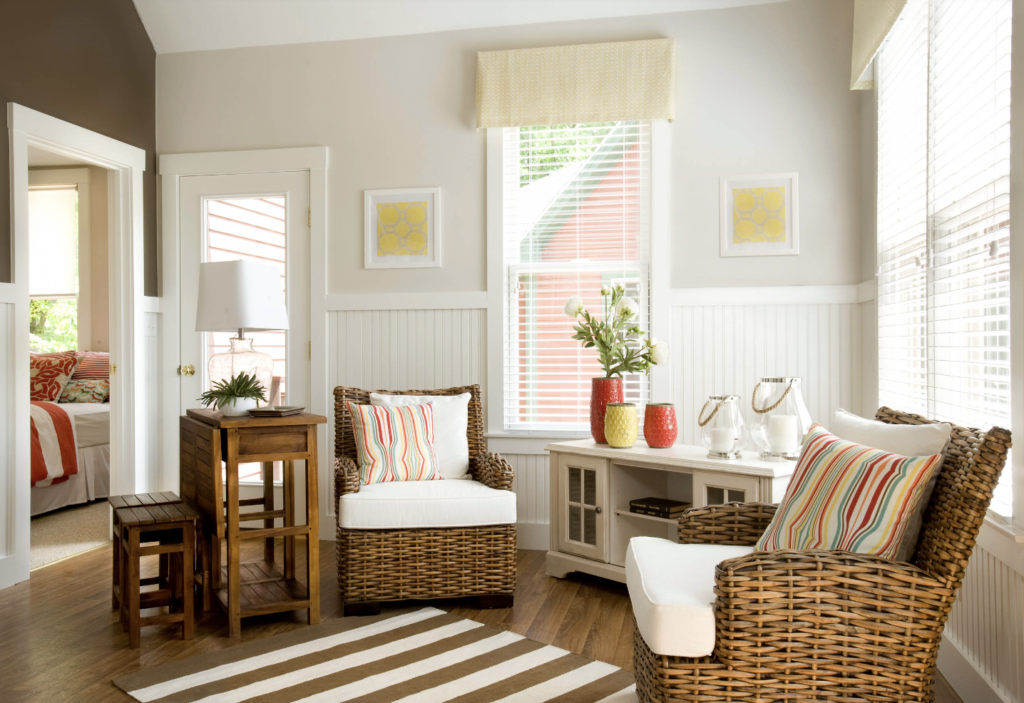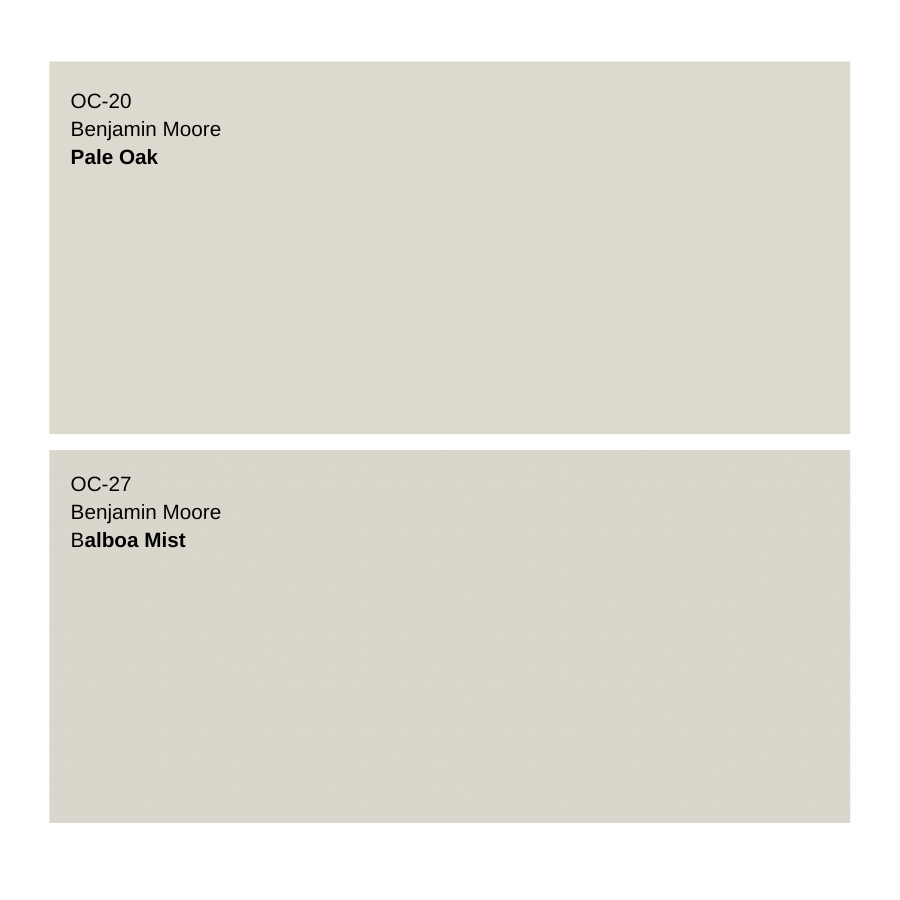Benjamin Moore Pale Oak – A Soft Light Greige
When searching for a neutral paint color don’t immediately go to white. Neutrals span a variety of shades and one that is almost always a homerun is a light gray or greige made by Benjamin Moore called Pale Oak. Benjamin Moore Pale Oak is a classic and timeless paint color that suits many different types of spaces. Whether it’s used in living areas like kitchens or family rooms or in bedrooms and bathrooms it’s an excellent color that coordinates well with a variety of color palettes. With surprising undertones, this color is a lovely warm greige that is rich yet subtle. If an elegant, warm neutral paint color is something you are looking for then Benjamin Moore Pale Oak is it. Let’s learn more about this gorgeous greige.

All About Benjamin Moore Pale Oak OC-20
Known as one of Benjamin Moore’s best-selling paint colors, Pale Oak is a go-to neutral for many designers and homeowners alike. Its popularity stems from its ability to work in a variety of spaces and lighting conditions. Benjamin Moore says this about Pale Oak, “with its warm gray undertones, this versatile neutral conjures the quiet majesty of white oak.” It’s a part of Benjamin Moore’s Off-White Collection. The bottom line is that Pale Oak really is a nice warm and inviting paint color. It’s a tried a true neutral that has earned its spot on the best-seller list.
What Color is Pale Oak and How Light is it?
Pale Oak can be described as a light greige (gray plus beige), or off-white. It has a hint of pink (more about its undertones in just a moment) in it which gives it that warmth that nudges it into the greige category. It’s a light color however it still has enough depth to not feel washed out even in rooms with an abundance of natural light.
What is the LRV?
The Light Reflectance Value or LRV of Benjamin Moore Pale Oak is 68.64
LRV is a useful tool for determining how light or dark a paint color is (100 being the whitest white and 0 being the darkest black). Keep in mind that “light” refers to Light Reflective Value, meaning the amount of light reflected. The more reflective the color, the brighter/lighter it will appear. There really is no “sweet spot” when it comes to LRV but for a light neutral I think this is a good place to land. Compared to another popular light gray paint color, Benjamin Moore Classic Gray, which has an LRV of about 74, Pale Oak has a slightly lower LRV because it has a little more depth of color because it reflects less light. Both colors are soft and on the walls, the variance in lightness isn’t very noticeable.
Is Pale Oak a Warm or Cool?
Pale Oak has a subtle warmth to it that’s not overwhelming. Truly, if we were looking for the “just right” light warm greige, this would be it. Warm grays are a bit unusual. Gray paint colors tend to run cool. That being said, this one isn’t a full gray. It’s got some beige mixed in which gives it that subtle warmth. It’s important to understand how undertones affect how paint colors look on the wall, especially in gray shades. Benjamin Moore Pale Oak is warm because of the undertones that help it to lean slightly towards the edge of beige or taupe. Unlike cool grays, warm grays don’t have to worry about this color appearing icy or cold. It’s always going to be warm and inviting.
What Undertones Does Benjamin Moore Pale Oak Have?
Here’s the deal. You must get familiar with undertones, especially if you are picking a gray paint color. Every gray paint color has undertones even the “true gray” paint colors. Some are more subtle and some are more obvious. Benjamin Moore Pale Oak is more a greige or a part gray, part beige paint color. The color comes from the yellow hue family with pink undertones. Pink undertones you say? I don’t want pink walls! Don’t let the pink undertones scare you off. These undertones keep Pale Oak on the warmer side giving it the warmth and sophistication that we love. I always recommend sampling paint colors in different lighting situations in your home to see how those undertones present themselves. This helps avoid the shock of unwanted undertones. That being said, Pale Oak is a best-seller for a reason, the warmth provided by its slight pink undertones creates a really sophisticated neutral that many enjoy.
What Paint Sheen Should I Use for Pale Oak?
An eggshell finish or a flat sheen is always my recommendation for living spaces and low-traffic areas because I like the matte finish. However, feel free to use the sheen of your choice for this paint color. Keep in mind, if you need something more durable then you can go to a satin or a semi-gloss just know that you will have a higher level of shine and those finishes are less forgiving to any wall blemishes or touch-ups you may have. Additionally, if you want to use Pale Oak on walls and trim you can create a subtle yet, gorgeous contrast by using a flat sheen on the walls and semi-gloss on the trim.
Benjamin Moore Pale Oak in Real Spaces
To truly appreciate the beauty of Pale Oak, it is important to see it in real spaces such as kitchens and areas with plenty of sunlight. This will give us a better understanding of how this shade looks and help determine if it is a good fit for your home.
There’s something about the contrast of a nice light greige paint color and crisp white trim. Pale Oak is the perfect backdrop for this soothing and restful bedroom space.
Pale Oak looks lovely in such a variety of interiors. You’ll notice that all of these spaces have different vibes but Pale Oak is successful in all of them. This entryway has Pale Oak on the walls with some millwork painted white on the bottom. Again, I love the contrast of Pale Oak with crisp white.

How luxurious is this home office painted Benjamin Moore Pale Oak. It’s a really calming color even in this small space. It feels cozy and Pale Oak really works well with the light flooring selection.

I read somewhere of a designer commenting on how Pale Oak goes with so many flooring colors and it’s true. Pale Oak looks great with all the different flooring options. This space feels a little cottage-y and I think the Pale Oak on the walls on top of the beadboard gives the right amount of warmth to this lovely room.
One thing that amazes me about Pale Oak is that it can be calming and inviting in one room and feel very luxe and sophisticated in another. This space oozes sophistication to me. I love the contrast of the creamy greige walls with the bright white trim and ceiling.

More contrast, more flooring options, same Pale Oak. Again, the message here is that Pale Oak works in a lot of different spaces, lighting, design styles, flooring colors, you name it. The Pale Oak color palette can be really such a variety because it’s such a friendly color.
What are some Complementary Colors to Pale Oak, OC-20?
Pale Oak is a nice neutral that really complements a large range of color palettes. I think you’ll find this a pretty easy color to work with. There are many different directions you can go with Pale Oak. You can stay with a neutral color palette and go more monochrome and work with more textures so stick with warm tans, grays, whites, and maybe black for contrast. You can also throw in splashes of color like pink, green, and even yellow all work lovely with Pale Oak. Since it’s a warm paint color, I was surprised at how well it works with blues. I think that tells you how versatile this paint color is. If you want some pairings, I like Benjamin Moore Chantilly Lace and White Dove as trim colors. I think Sherwin Williams Evergreen Fog would be a stunning accent color if you want a bold, moody pop of color.
Where to Use BM Pale Oak?
Everywhere! Yes, Pale Oak is an all-over paint color. I’m not sure about an exterior paint color as it’s quite light and can wash out easily with harsh light but as for interior paint… I say go for it. This is a color that you truly could use all over your home and expect it to look warm, inviting, and polished. Here are some of the places I’d use Pale Oak.
- In kitchens on walls or on cabinetry
- Bedroom
- Living Room
- Dining Room
- Bathroom on walls or cabinetry
- Entryway
- Bathroom
- Hallway
Additionally pairing Pale Oak with bold accent walls or other wall treatments like board and batten or other wood accent walls is a really nice touch.
What are Some Alternative Neutral Paint Colors to Pale Oak?
I’m glad you asked – let’s take a look at some other neutral paint colors that may be good alternatives to Pale Oak.
Benjamin Moore Pale Oak vs. Benjamin Moore Balboa Mist

Balboa Mist is veryyyyy close to Pale Oak. Balboa Mist’s undertones are more violet than pink which differs from Pale Oak. Pale Oak is also slightly lighter than Balboa Mist but just barely. The LRV of Pale Oak is slightly higher than Balboa Mist meaning it reflects more light (is lighter) with an LRV of 68.64 compared to Balboa Mist’s LRV of 65.53. Both colors are in the Benjamin Moore Off Whites Collection. If you want something slightly cooler (again, just barely) Balboa Mist is a good option. Both colors are warm and inviting greiges that look great as all-over paint colors.
Benjamin Moore Pale Oak vs. Benjamin Moore Classic Gray

Benjamin Moore Classic Gray is another comparable paint color to Pale Oak. A bit lighter, Classic Gray is a warm gray that is light enough that it could function as an off-white paint color. While Pale Oak is more of a greige paint color, Classic Gray feels solid (light) gray. Both colors are warm and luxurious giving an inviting feel to a space. Classic Gray has an LRV of 73.67 compared to Pale Oak’s 68.64. Both colors are light enough that in rooms with a lot of natural light, they can wash out a bit so you want to be careful there.
Benjamin Moore Pale Oak vs. Benjamin Moore Swiss Coffee

Benjamin Moore Swiss Coffee is a creamy neutral that creates a beautiful, soft backdrop to any space. It’s a nice choice because it works in a variety of spaces. We had this paint color in our entire house at our previous rental and I enjoyed the color. Compared to Pale Oak, Swiss Coffee is significantly lighter with an LRV of 81.91. It’s a true off-white paint color. I think it’s a great alternative if you want something lighter, that still feels warm and inviting.
Before you commit to any paint color you want to be sure to sample the colors you are considering. I think it’s really great idea to stick samples of your desired color in the space you’re thinking about painting and check in on it at varying times throughout the day to get a true, accurate idea of what the color is going to look like in your space. If you buying paint pot samples, consider using large posterboard for samples to give yourself the most accurate idea of the color. SAMPLIZE offers convenient peel-and-stick paint samples that are affordable, easier, and better for the environment than traditional paint pots. They are mess-free, display colors just like a wall, are reusable so you can try them out all over the room, and arrive on your doorstep in just a few days!
In Conclusion
Benjamin Moore Pale Oak OC-20 is a classic, balanced paint color that perfectly complements neutral and bold color palettes. Not only does this timeless light greige provide a subtle warmth to any room in your home, but it also works with a variety of color palettes making it an ideal choice for any interior painting project. If you’re looking for alternatives to Pale Oak, consider Benjamin Moore Balboa Mist, Classic Gray, or Swiss Coffee. With any of these timeless paint colors you can expect a sophisticated and classic look that will make you swoon.








